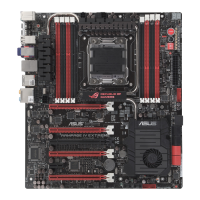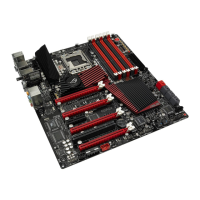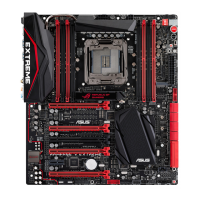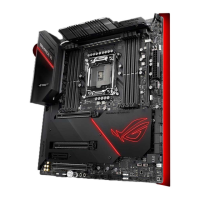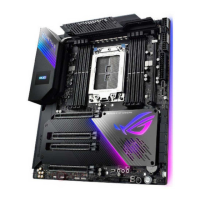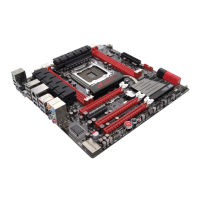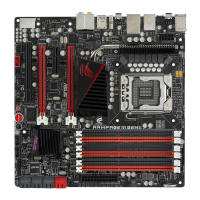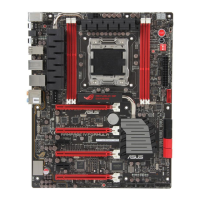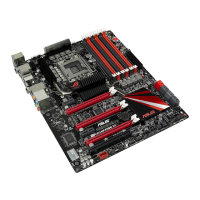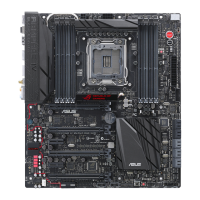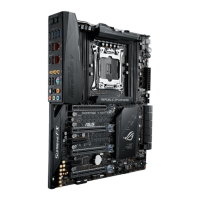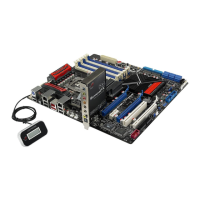
Do you have a question about the Asus Rampage II Extreme - Republic of Gamers Motherboard and is the answer not in the manual?
| Brand | Asus |
|---|---|
| Model | Rampage II Extreme - Republic of Gamers Motherboard |
| Category | Motherboard |
| Language | English |
Statement regarding compliance with FCC regulations for digital devices.
Statement regarding compliance with Canadian radio noise emissions regulations.
Guidelines for preventing electrical shock hazards during system handling.
Guidelines for safe motherboard installation and handling to prevent damage.
Describes the structure and content of the user manual.
Explains symbols, text formatting, and command usage in the manual.
Details CPU socket, processor support, and chipset features.
Outlines memory architecture, module support, and expansion slot types.
Covers multi-GPU support, storage controllers, and networking capabilities.
Details high definition audio features and IEEE 1394 connectivity.
Provides a welcome message and lists items included in the motherboard package.
Showcases key features like ROG, Intel CPU support, X58 chipset, and DDR3 memory.
Describes support for multi-GPU, high-speed interfaces, and networking technologies.
Details high-definition audio, capacitor quality, and environmental compliance.
Explains ROG-specific tools for performance tuning and hardware monitoring.
Details BIOS flexibility, CPU upgrades, system tuning, and protection mechanisms.
Highlights exclusive ROG features like enhanced audio, diagnostic displays, and fan control.
Describes cooling technologies, intelligent fan control, and power management features.
Covers optional accessories, system customization, BIOS utilities, and recovery features.
Provides essential precautions before installing motherboard components or changing settings.
Visual guide to motherboard components and the SupremeFX X-Fi audio card.
Lists internal and external connectors, jumpers, and slots with corresponding page references.
Instructions on orienting the motherboard in the chassis and using screw holes.
Safety guidelines and checks before installing the CPU, including socket and PnP cap handling.
Step-by-step instructions for correctly installing the CPU into the LGA1366 socket.
Guide on installing the CPU heatsink and fan assembly for optimal thermal performance.
Instructions for safely uninstalling the CPU heatsink and fan assembly.
Details DDR3 DIMM socket locations and recommended memory configurations for performance.
Explains memory size, CAS latency, OS compatibility, and module limitations.
Step-by-step guide for installing DDR3 memory modules into DIMM sockets.
Instructions for safely removing DDR3 memory modules from DIMM sockets.
Procedures for physically installing expansion cards like graphics or network cards.
Adjusting BIOS settings and installing drivers after expansion card installation.
Details standard and motherboard-specific interrupt (IRQ) assignments for PCI devices.
Information on standard PCI slots and their compatibility with add-on cards.
Details on PCI Express x1 slots and their supported device types.
Information on PCI Express 2.0 x16 slots for graphics cards.
Explains operating modes and configurations for PCIe x16 slots in multi-GPU setups.
Instructions for clearing CMOS settings using the CLRTC_SW jumper and switch.
Explains the jumper settings for selecting BIOS 1 or BIOS 2 for booting.
Identifies and describes the ports located on the motherboard's rear panel.
Details audio port functions and other rear panel connectors like USB, SATA, CMOS.
Describes the connector for the floppy disk drive signal cable.
Details the connector and configuration for IDE devices.
Describes the SATA connectors for hard drives and optical drives, including RAID support.
Details the connector for external Serial ATA hard disk drives.
Describes the internal USB 2.0 connectors for front panel USB ports.
Details the connector for IEEE 1394a devices.
Identifies connectors for CPU, chassis, power, and optional fans.
Describes connectors for temperature monitoring sensors.
Details the connector for chassis intrusion detection sensors.
Describes optical drive, front panel, and digital audio connectors.
Explains the ATX power supply connectors and PSU recommendations.
Describes the connector for the Republic of Gamers heatpipe assembly illumination.
Details connectors for system power LED, HDD activity LED, speaker, and buttons.
Guides users on installing the ASUS Q-Connector for simplified front panel connections.
Introduces onboard power and reset switches for system tuning.
Details the various options available within the TweakIt utility for system monitoring and configuration.
Describes the ProbeIt feature for convenient and accurate motherboard voltage measurements.
Provides instructions for installing an optional fan for enhanced cooling.
Step-by-step guide for installing the SupremeFX X-Fi audio card.
Instructions for installing the EL I/O shield and the external LCD Poster.
Information on installing third-party fusion blocks according to vendor specifications.
Guides on the first system startup and interpretation of BIOS beep codes for troubleshooting.
Instructions for shutting down the system using Windows Vista and XP.
Explains how to use the system power switch for sleep or soft-off modes.
Covers utilities for managing and updating the motherboard BIOS.
Explains how to enter and navigate the BIOS Setup utility.
Details settings for overclocking and system performance adjustments.
Provides an overview of basic system information accessible from the Main menu.
Covers advanced settings for CPU, chipset, and system devices.
Explains settings related to Advanced Power Management (APM) and ACPI.
Details options for configuring system boot devices and priorities.
Describes various BIOS utilities for system management and backup.
Explains options for saving, discarding, or loading BIOS settings.
Guides on using ASUS Update to download and install BIOS from the internet.
Instructions for updating BIOS using a downloaded BIOS file with ASUS Update.
Steps to create a bootable floppy disk for BIOS updates or DOS utilities.
Explains the built-in EZ Flash 2 utility for BIOS updates via floppy or USB.
Details using the AFUDOS utility for BIOS updates and backups in a DOS environment.
Describes the CrashFree BIOS 3 utility for restoring BIOS from DVD, floppy, or USB.
Overview of the BIOS setup screen structure, including menu bar and navigation keys.
Explains menu items, sub-menus, configuration fields, pop-ups, scroll bars, and help functions.
Allows tuning of system performance through CPU and DRAM frequency, ratios, and voltages.
Options for automatically adjusting CPU and memory performance based on profiles.
Selection of overclocking modes including Manual, Auto, X.M.P., CPU/Memory Level Up, and ROG Profile.
Adjustments for memory overclocking via Level Up or specific profiles like X.M.P.
Settings for CPU core ratio, BCLK, and PCI Express frequencies.
Options to adjust DRAM, Uncore Clock Ratio (UCLK), and QuickPath Interconnect (QPI) frequencies.
Detailed settings for optimizing DRAM timings like CAS Latency, RAS to CAS Delay, and PRE Time.
Fine-tuning DRAM timings related to write-to-read delays.
Controls for DRAM timing modes and round trip latencies across memory channels.
Further DRAM timing adjustments for specific read/write delay scenarios.
Settings for power saving phases, CPU voltage stability, and BCLK overclocking.
Options for voltage overclocking and CPU VCore voltage adjustment with risk indicators.
Adjustments for various system voltages including CPU PLL, IOH, ICH, and DRAM bus.
Explains the color coding used for voltage settings to indicate risk levels.
Settings for DRAM reference voltage and selection of debug modes.
Controls for TweakIt functionality, CPU/PCIE spread spectrum, and clock skew adjustments.
Basic system configuration options for time, date, floppy drive, and language.
Displays detected SATA devices and provides overall system information.
Settings for SATA drive types, LBA mode, multi-sector transfer, PIO, DMA, and SMART monitoring.
Options for configuring SATA mode (IDE, AHCI, RAID), HDD write protection, and detect timeouts.
Settings specific to AHCI mode, including boot time out and SATA port configurations.
Displays BIOS version, CPU specs, system memory, and boot status.
Provides details on the CPU and its detected features.
Settings for CPU features like C1E, Prefetcher, Virtualization, TM Function, Execute Disable Bit, HT Technology, and Core Activation.
Configuration options for North Bridge and Intel VT-d for chipset features.
Enables or disables onboard devices like audio, front panel audio, eSATA/PATA, Marvell LAN, and 1394 controller.
Options to enable/disable LAN boot ROM and the onboard IEEE 1394a controller.
Settings for enabling USB functions, controllers, modes, EHCI hand-off, and legacy support.
Configuration for Plug and Play (PnP) devices, including OS-driven configuration and USB legacy support.
Controls for LCD Poster backlight, mode, hardware monitoring display, and onboard LEDs.
Specific selections for CPU, NB, and SB LED displays, and EL Light control.
Configuration for iROG CrashBIOS Rule and Timer Keeper operation modes.
Options for system suspend states and VGA BIOS behavior during S3 resume.
Configuration for ACPI 2.0 support and ACPI APIC support.
Settings for AC power loss behavior, RTC alarms, and wake-up events from PCI/PCIE devices or keyboard.
Monitors system voltages, temperatures, and fan speeds.
Controls for CPU, Chassis, Power, and Optional fan speeds and profiles.
Details fan control modes (Disable, Standard, Silent, Turbo, Intelligent, Stable, User) for optimal cooling.
Sets the sequence for bootable devices.
Options to adjust boot behavior like Quick Boot, Full Screen Logo, and error handling.
Manages BIOS boot selection when using BIOS Flashback functionality.
Options to set, change, or clear the supervisor password for BIOS access.
Controls user access restrictions and sets/clears user passwords and password checks.
Lists BIOS utilities for EZ Flash, O.C. Profile, AI NET 2, and BIOS Flashback.
Allows saving, loading, and starting overclocking profiles for BIOS settings.
Enables or disables checking of the LAN cable status during POST.
Facilitates backing up or restoring BIOS content between BIOS 1 and BIOS 2.
Provides options to save changes, discard changes, or load default settings before exiting BIOS.
Guidance on installing compatible operating systems like Windows XP/Vista.
Information on the contents of the motherboard support DVD, including drivers and applications.
Lists available device drivers for installation from the support DVD.
Lists applications and software utilities available on the support DVD.
Monitors system health, including fans, temperature, and voltages.
Utilities for system management, data transfer, and network controller applications.
Lists essential software like PDF reader, multimedia drivers, antivirus, and overclocking tools.
Options for creating driver disks for Intel ICH10R RAID and JMicron JMB36X controllers.
Access to supplementary user manuals in PDF format.
Provides access to video clips showcasing ROG motherboard performance.
Provides contact details for ASUS technical support and information.
Access to additional information about the motherboard and support DVD contents.
Guides on browsing DVD contents graphically, accessing technical support forms, and viewing file lists.
Customizes the motherboard boot logo image.
Utility for diagnosing LAN cable faults and shorts using Time Domain Reflectometry.
Steps to install the Sound Blaster X-Fi audio drivers and utility for enhanced audio.
Interface for configuring audio settings, speaker types, and testing audio channels.
Controls for environment effects, 3D virtual surround sound, and audio dynamics.
Features for managing volume fluctuations and customizing equalizer settings.
Interface for selecting recording devices and adjusting playback volumes.
Software for monitoring system health and detecting potential problems.
Explains PC Probe II buttons, sensor alerts, and preference settings for customization.
Features for displaying and repositioning hardware monitor panels on the desktop.
Visual indicators for sensor values exceeding or falling below thresholds.
Tools for accessing Windows Management Instrumentation and Desktop Management Interface information.
Tools for viewing PCI device information and real-time system usage statistics.
Visualizations of CPU utilization and hard disk drive space.
Visualization of used and available physical memory.
Adjusting sensor thresholds and customizing alerts within the PC Probe II application.
Central hub for launching ASUS utilities like EPU-6 Engine, TurboV, and Fan Xpert.
Details on AI Suite buttons for launching utilities and the monitor window for system status.
Utility to minimize power consumption and system noise during idle periods.
Intelligent fan control for adjusting CPU and chassis fan speeds based on temperature.
Explains fan control modes (Disable, Standard, Silent, Turbo, Intelligent, Stable, User) for optimal cooling.
Allows immediate CPU overclocking with presets via Windows environment.
Energy-efficient tool for managing system performance and power saving modes.
Overview of the EPU-6 Engine interface, modes, and CO2 emission tracking.
Detailed configuration options for CPU frequency, voltage, chipset voltage, and disk/fan controls.
Table detailing configuration options across different EPU-6 Engine modes.
Tool for real-time overclocking of CPU frequency, voltage, and memory settings.
Advanced options for CPU/chip voltage, DRAM reference voltage, and CPU ratio adjustments.
Interface for adjusting CPU core ratio and frequency, specific to Intel Core i7 Extreme processors.
Explains different RAID levels and their benefits for data storage and performance.
Steps for installing SATA hard disks for optimal performance and RAID array creation.
Guides on setting the RAID item in BIOS Setup to enable RAID functionality.
Introduces the utility for creating RAID volumes using Intel ICH10R Southbridge.
Step-by-step instructions for creating a RAID 0 volume with data striping.
Step-by-step instructions for creating a RAID 1 volume with data mirroring.
Step-by-step instructions for creating a RAID 10 volume combining striping and mirroring.
Step-by-step instructions for creating a RAID 5 volume with data striping and parity.
Procedures to create a RAID driver disk using the support DVD without entering the operating system.
Instructions for creating a RAID driver disk within the Windows operating system.
Guide for installing and enabling ATI CrossFireX for multi-GPU setups.
Guide for installing and enabling NVIDIA SLI for multi-GPU setups.
Step-by-step instructions for installing dual SLI-ready graphics cards.
Step-by-step instructions for installing triple SLI-ready graphics cards.
Instructions for installing NVIDIA graphics card drivers that support SLI technology.
Steps to enable the SLI feature within the NVIDIA Control Panel.
Methods for accessing and launching the NVIDIA Control Panel.
Steps to configure dual SLI settings within the NVIDIA Control Panel.
Steps to configure triple SLI settings within the NVIDIA Control Panel.
Lists and describes POST codes for diagnosing system startup issues.
Continues the list and descriptions of POST codes for system diagnostics.
Final part of the POST code definitions for system diagnostics.
